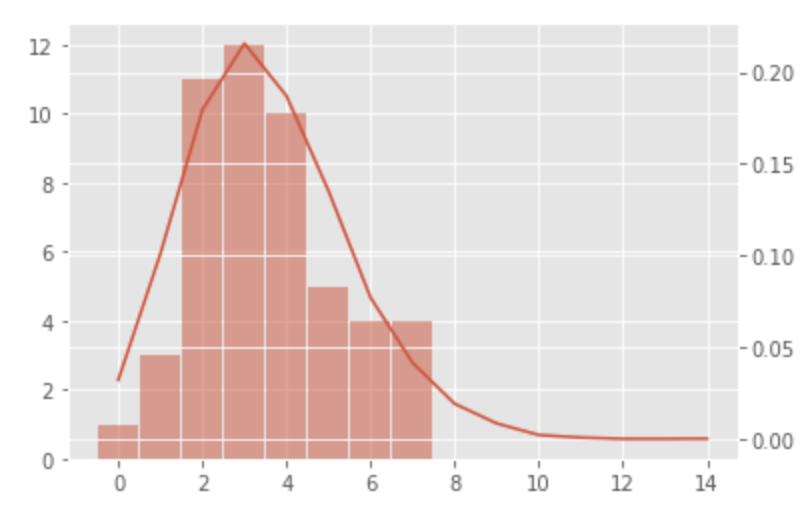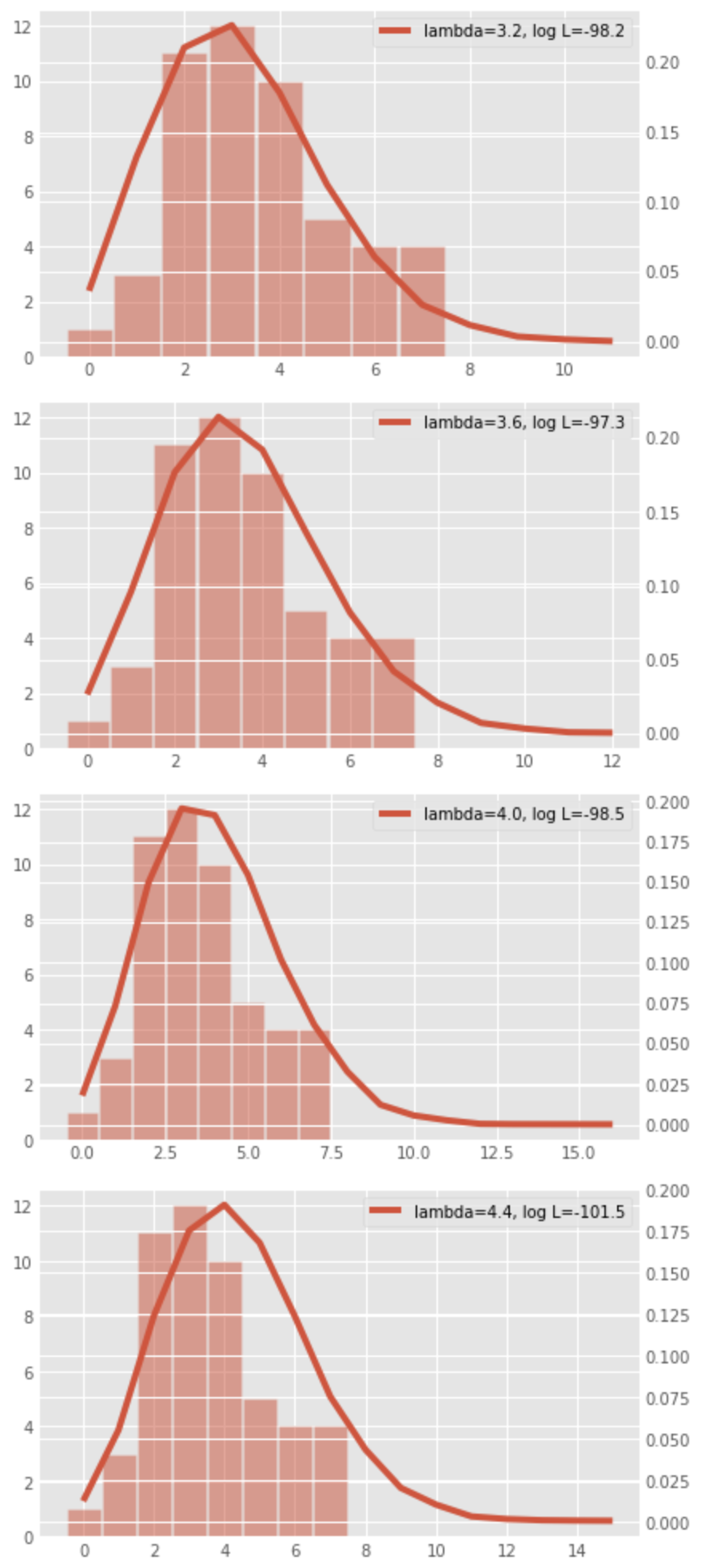What is a statistical model
A statistical model is a mathematical model that explains patterns or laws about observed data. It selects a probability distribution according to the characteristics of the data and estimates the parameters of the probability distribution that can successfully explain the observed data.
Parameter estimation
I will perform parameter estimation in Python for the following sample data with a sample size of 50.
data = [2,2,4,6,4,5,2,3,1,2,0,4,3,3,3,3,4,2,7,2,4,3,3,3,4,
3,7,5,3,1,7,6,4,6,5,2,4,7,2,2,6,2,4,5,4,5,1,3,2,3]
Data investigation
First, let us look at a histogram of the data.
import matplotlib.pyplot as plt
import seaborn as sns
%matplotlib inline
plt.style.use('ggplot')
plt.figure(figsize=(10,5))
data = [2,2,4,6,4,5,2,3,1,2,0,4,3,3,3,3,4,2,7,2,4,3,3,3,4,
3,7,5,3,1,7,6,4,6,5,2,4,7,2,2,6,2,4,5,4,5,1,3,2,3]
plt.hist(data, bins = [-0.5 + v for v in range(max(data) + 2)], alpha=0.5, rwidth=0.95)
plt.xlabel('data')
plt.ylabel('Frequency')

Next let us look at a summary of the data.
import pandas as pd
df = pd.DataFrame(data, columns=['x'])
df.describe()
| x | |
|---|---|
| count | 50.00000 |
| mean | 3.56000 |
| std | 1.72804 |
| min | 0.00000 |
| 25% | 2.00000 |
| 50% | 3.00000 |
| 75% | 4.75000 |
| max | 7.00000 |
Let us look at the sample variance.
# sample variabce
df.var()
2.986122
The survey confirmed the following:
- Mountain-like distribution
- Data are count data (non-negative integers)
- Sample mean is 3.56
- Sample variance is 2.99
Assumptions of probability distribution
From the sample data, we assume a probability distribution that the population follows. We know the following about the sample data.
- The data is count data
- The lower bound is 0 but the upper bound is unknown
- The sample mean is 3.56 and the sample variance is 2.99, which are relatively close
From the above characteristics, we assume a Poisson distribution with
Poisson distribution vs. sample distribution
Visualize the Poisson distribution of
fig, ax1 = plt.subplots()
plt.hist(data, bins = [-0.5 + v for v in range(max(data) + 2)], alpha=0.5, rwidth=0.95)
poisson_values = poisson.rvs(3.56, size=10000)
prod = (pd.value_counts(poisson_values) / 10000).sort_index()
ax2 = ax1.twinx()
ax2.plot(prod)
plt.show()

It appears that the distribution of the sample data can be represented by a Poisson distribution with
Parameter estimation of the assumed probability distribution
The parameters of the probability distribution are estimated based on the sample data. Here we use a parameter estimation method called maximum likelihood estimation.
Maximum likelihood estimation is a parameter estimation method that searches for the parameter that maximizes the likelihood, a statistic that expresses how well it fits the observed data. In this case, the parameter is
The likelihood is the product of the probabilities for all the sample data. The likelihood is a function of the parameter, denoted by
where
We examine
The following figure shows the shape of the distribution and the value of
import matplotlib.pyplot as plt
import pandas as pd
import seaborn as sns
import sympy
from scipy.stats import poisson
%matplotlib inline
plt.style.use('ggplot')
plt.figure(figsize=(10,5))
lams = np.arange(3.2,4.5,0.4)
for i, lam in enumerate(lams):
log_l = 0
for y in data:
f = (lam**y)*sympy.exp(-lam)/sympy.factorial(y)
logf=sympy.log(f)
log_l = log_l + logf
fig, ax = plt.subplots()
ax.hist(data, bins = [-0.5 + v for v in range(max(data) + 2)], alpha=0.5, rwidth=0.95)
poisson_values = poisson.rvs(lam, size=10000)
prod = (pd.value_counts(poisson_values) / 10000).sort_index()
ax2 = ax.twinx()
ax2.plot(prod, label=f'lambda={round(lam, 1)}, log L={round(log_l, 1)}')
plt.legend()
plt.show()

We can see that the log-likelihood is likely to be maximized around
To derive the maximum log likelihood, we can find
Computing the above equation, we see that the likelihood is maximized when
Which probability distribution should be used for statistical models
When choosing a probability distribution for a statistical model to explain observed data, following points need to be checked:
- Type of data (discrete or continuous)
- Range of data
- Relationship between sample variance and sample mean
For some probability distributions, the necessary conditions that may be used as probability distributions for statistical models are as follows.
| Type of data | Range of data | Relationship between sample variance |
Probability distribution |
|---|---|---|---|
| Discrete | Poisson distribution | ||
| Discrete | Negative binomial distribution | ||
| Discrete | Binomial distribution | ||
| Continuous | Normal distribution | ||
| Continuous | Log-normal distribution | ||
| Continuous | Gamma distribution | ||
| Continuous | Beta distribution |